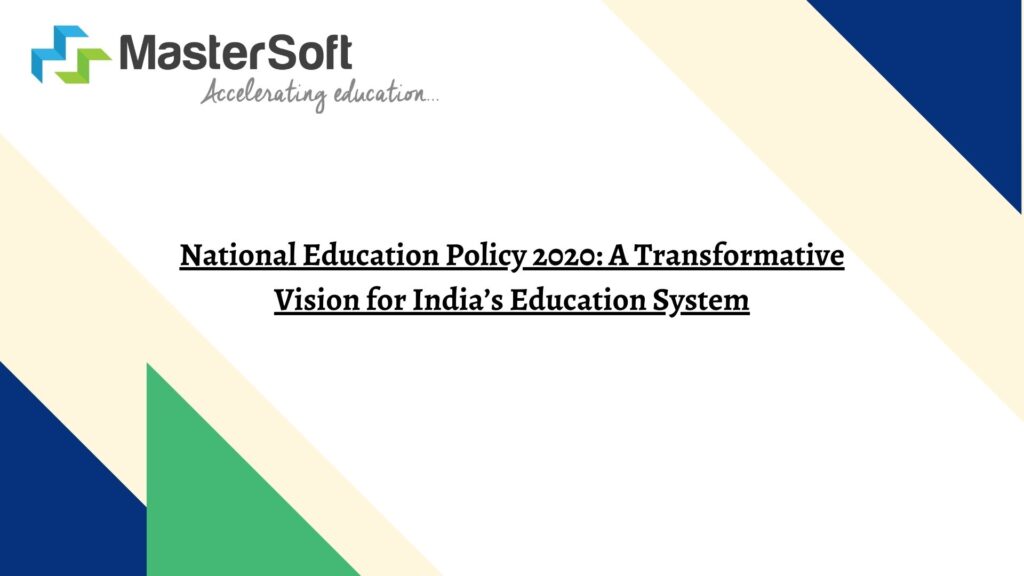The National Education Policy 2020 (NEP 2020) marks a historic milestone in the evolution of India’s education system. Introduced by the Government of India, this policy aims to overhaul the existing structure, make education more holistic, and align it with global standards. It emphasizes accessibility, equity, quality, and accountability while focusing on nurturing the creative potential of every individual.
This blog delves into the goals, features, and potential impact of NEP 2020 on India’s education landscape.
Goals of NEP 2020
NEP 2020 envisions an education system that:
- Prepares learners for the challenges of the 21st century.
- Focuses on holistic and multidisciplinary approaches.
- Ensures universal access to quality education for all children.
- Promotes equity and inclusivity across all levels of education.
- Encourages lifelong learning through flexible curricula and pedagogies.
Key Highlights of NEP 2020
1. Universalization of Education
NEP 2020 aims to achieve 100% Gross Enrollment Ratio (GER) in school education by 2030. It focuses on providing free and compulsory education for children aged 3-18 years by expanding the Right to Education Act (RTE) to include early childhood care and secondary education.
2. Restructuring School Education
The traditional 10+2 structure has been replaced with a 5+3+3+4 design, which corresponds to:
- Foundational Stage (5 years): Play-based and activity-based learning for ages 3-8.
- Preparatory Stage (3 years): Experimental learning for ages 8-11.
- Middle Stage (3 years): Subject-oriented learning for ages 11-14.
- Secondary Stage (4 years): Multidisciplinary study for ages 14-18.
3. Emphasis on Early Childhood Care and Education (ECCE)
High-quality ECCE will be universally provided by 2030 through initiatives such as Anganwadis, pre-schools, and community-based programs.
4. Multilingual Education
The policy emphasizes mother tongue or regional language as the medium of instruction up to Grade 5, promoting cognitive development and cultural identity.
5. Holistic and Multidisciplinary Approach
Students will have the flexibility to choose subjects across streams, allowing for a multidisciplinary education model. This will bridge the gap between science, arts, and vocational studies.
6. Assessment Reforms
NEP 2020 introduces competency-based assessments that focus on higher-order thinking skills, critical thinking, and conceptual understanding rather than rote learning.
7. Technology Integration
Technology will play a pivotal role in education, with the establishment of a National Educational Technology Forum (NETF) to guide the use of digital tools in teaching, learning, and assessment.
8. Higher Education Reforms
The policy aims to increase the GER in higher education to 50% by 2035 by:
- Consolidating institutions into larger, multidisciplinary universities and colleges.
- Establishing a Higher Education Commission of India (HECI) for regulation and accreditation.
- Introducing a four-year undergraduate degree program with multiple exit options.
9. Vocational Education and Skill Development
Vocational training will be integrated into the school curriculum from Grade 6 onwards. The aim is to equip students with job-ready skills through internships and hands-on training.
10. Teacher Training and Professional Development
The policy stresses the need for continuous professional development of teachers. A National Professional Standards for Teachers (NPST) will be introduced to ensure quality teaching.
Impact of NEP 2020 on India’s Education System
1. Bridging Equity Gaps
NEP 2020 prioritizes inclusive education by providing scholarships, financial aid, and infrastructure support to underprivileged sections, including Scheduled Castes (SCs), Scheduled Tribes (STs), Other Backward Classes (OBCs), and students with disabilities.
2. Enhancing Quality of Education
With its focus on innovative teaching methodologies and outcome-based learning, the policy aims to enhance the overall quality of education in India, making students globally competitive.
3. Promoting Lifelong Learning
The policy encourages a culture of continuous learning by integrating skill development and lifelong education, ensuring that learners can adapt to changing career demands.
4. Preparing for Future Challenges
NEP 2020 emphasizes digital literacy, coding, artificial intelligence, and data science, equipping students to thrive in a technology-driven world.
Challenges in Implementation
Despite its transformative potential, NEP 2020 faces several challenges:
- Infrastructure Constraints: Many schools and institutions lack the resources needed for effective implementation.
- Teacher Training: Ensuring that teachers are equipped to adopt new pedagogies and technologies.
- Regional Disparities: Bridging the urban-rural divide to ensure equal access to quality education.
- Financial Resources: Allocating adequate funding to achieve the ambitious goals outlined in the policy.
The Way Forward
For NEP 2020 to succeed, collaborative efforts are required from all stakeholders, including the government, educators, parents, and students. Key steps include:
- Investing in infrastructure and technology.
- Conducting widespread teacher training programs.
- Raising awareness about the policy’s benefits among communities.
Conclusion
The National Education Policy 2020 is a visionary step toward reshaping India’s education system. By focusing on inclusivity, flexibility, and holistic development, it lays a strong foundation for preparing students to meet the challenges of the future. While challenges remain, a committed effort toward implementation can turn NEP 2020’s vision into reality, ensuring a brighter and more equitable future for all learners.

